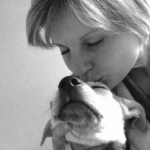
 Once you have found out that your pet has cancer, there is some information that your veterinarian or veterinary oncologist needs in order to help you with this difficult decision.
Once you have found out that your pet has cancer, there is some information that your veterinarian or veterinary oncologist needs in order to help you with this difficult decision.
Tumor staging is routinely performed by your veterinarian or by a veterinary cancer specialist (oncologist). Staging involves determining if the tumor has spread to the lungs or the lymph nodes or to other internal organs.
A chest radiograph (x-ray) can determine if there is metastasis to the lungs. Typically your vet will take three “views” of the lungs which gives the most accurate determination of pulmonary metastasis.
Abdominal ultrasound and/or abdominal radiographs, or cat scans or MRI’s can also aid the doctor in determining the stage at which the cancer has progressed in your pet.
Some cancers are so aggressive that if their growth is left unchecked, they will cause the animal’s death fairly rapidly. For these individuals, it may be necessary to use a more aggressive cancer therapy to ”keep the patient alive” while you are beginning to offer your animal some alternative therapies.
Surgical Removal and Margins
[/mk_fancy_title]
The best treatment for a solid tumor is complete surgical removal with what is termed wide margins. Margins are an area around the perimeter of the tumor that is healthy tissue. Tumors often will send out tendrils of cancerous tissue into the healthy tissue that surrounds them. This is why surgically we also need to remove at least an inch or more of healthy tissue around the tumor so we can “get it all”.
When the excised mass is sent in for histopathology the pathologist will write in their report whether any tumor cells extend to the margins of the sample. We don’t want this, it means that the tumor might grow back. What we are looking for are “clean margins” indicating complete removal of the mass. This means that its highly unlikely that the tumor will return. In other words, the cancer has been cured!
Do All Cancers Need Treatment?
[/mk_fancy_title]
Not all cancer is bad and needs to be removed or treated. Skin masses, for instance, that are found in dogs are not always a bad thing. Statistically, the majority of these skin masses in the dog are benign. Dogs will also commonly get cysts and injuries which have the appearance of tumors.
Lipomas
[/mk_fancy_title]
The most common skin mass in dogs is the “lipoma”, or benign tumor of adipose (fat) cells. These appear as soft jelly-like swellings under the skin. They are freely moveable, and can grow to quite large proportions. When they are disturbing the local area of tissue in which they are growing, or are growing too large, then these lipomas should be removed surgically.
Lipomas don’t commonly reoccur after surgical removal. It is theorized that lipomas may be due, in part, to the highly processed fats that are present in commercial foods. Animals with thyroid conditions may be more susceptible to the formation of lipomas. Some people want these removed because they can be unsightly, and if the anesthetic risk isn’t unsafe, then they may opt to remove these masses. Often, while I have a patient into my clinic for a procedure that requites anaesthesia (dental cleaning, for instance) I will suggest they consider removal at that time.
Cats
[/mk_fancy_title]
Skin masses in cats, by contrast, are more likely to be malignant. In the past 20 years veterinarians are starting to find a very aggressive malignancy in cats. This tumor has been associated with the site of the vaccination injection for rabies and leukemia over the shoulder blades. For this reason, it has been recommended that cats receive these vaccinations in their rear legs, so that if it does become cancerous, the leg can be amputated much more easily than the tumor can be removed from over the shoulder blades at the base of the neck.
The best solution for this is to minimize the vaccinations you give your cat. Studies have found that we don’t need to give every vaccination every year, and that many pets will remain protected for these diseases we vaccinate against for many years, and don’t need to be boostered every year. There now are blood tests that can tell us if your pet needs to be vaccinated again. Ask your vet about this.




